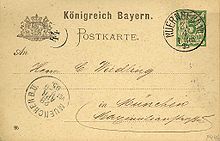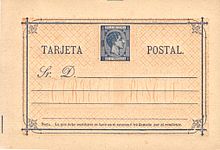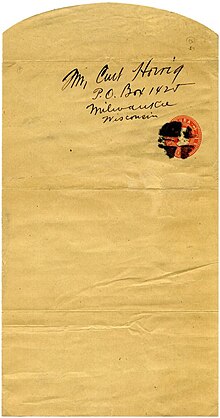







A piece of postal stationery is a stationery item, such as a stamped envelope, letter sheet, postal card, lettercard, aerogram or wrapper, with an imprinted stamp or inscription indicating that a specific rate of postage or related service has been prepaid.[1][2] It does not, however, include any postcard without a pre-printed stamp,[3] and it is different from freepost for preprinted cards issued by businesses. In general, postal stationery is handled similarly to postage stamps; sold from post offices either at the face value of the printed postage or, more likely, with a surcharge to cover the additional cost of the stationery.[4] It can take the form of an official mail issue produced only for the use of government departments.[4][5]
- ^ "Postal Stationery in Linns.com Reference section". Archived from the original on 2008-12-22. Retrieved 2010-11-30.
- ^ "United Postal Stationery Society's Postal Stationery 101: What Is Postal Stationery?".
- ^ "Baadke, Michael; Postal cards are another stamped collectible in Linns.com Refresher Course section". Archived from the original on 2009-08-14. Retrieved 2010-12-01.
- ^ a b "Miller, Rick; Postal stationery offers collecting variety in Linns.com Refresher Course section". Archived from the original on 2012-04-06. Retrieved 2010-12-01.
- ^ Horning, Otto; The Illustrated Encyclopedia of Stamp Collecting (1970).